Japanese Beetle Invasion!
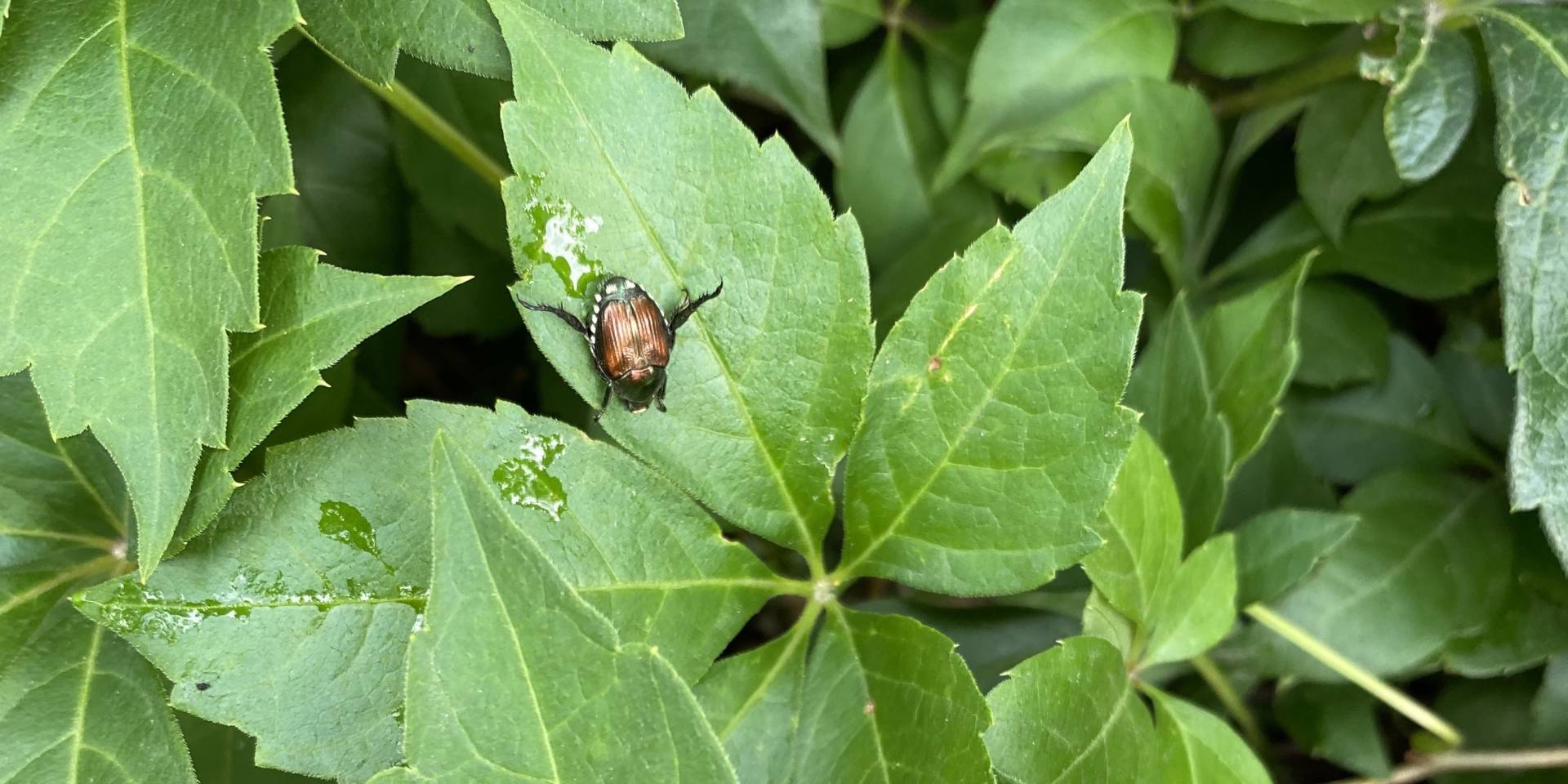
This pretty, iridescent little muncher that can wreak havoc on your roses, Virginia creepers and according to the Colorado Department of Agriculture, over 300 different plant species found in our landscapes! If you come across one of these little copper-backed creatures on your ornamentals and give it the heave ho, know that it will lay eggs that survive winter and you’ll have major infestation greeting you NEXT summer.
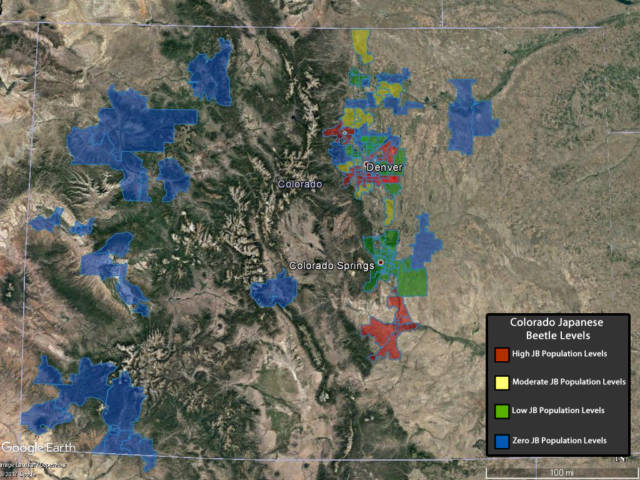
Our neighbors to the south (Colorado Springs) and north (Lone Tree, Highlands Ranch and beyond) have battled the dreaded Japanese beetle in recent months with mixed results. The battle happens on two fronts with adults and larvae and gardening experts offer this advice for the safest, most effective ways to rid your plants of the destructive little pests and their offspring!
Extermination How-To
In a recent Denver Post article, Colorado gardening experts suggest using the pluck-and-drown method on Japanese beetles – picking them off plants and dropping them in a jar of soapy water (some Next Door posters suggest Dawn® dishwashing soap). When the beetles feed off your plants, they emit volatiles that attract more beetles. So, by removing a few each evening, there are fewer beetles left the next day to beckon more of their friends!
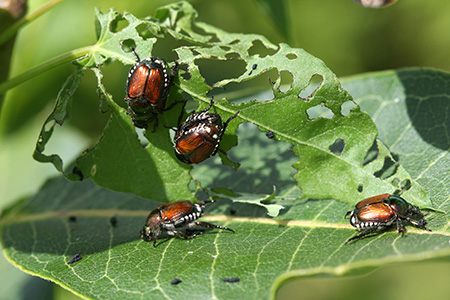 A few years ago, the town of Palisade, CO, where tasty, delectable peaches are grown, feared it would lose its peach crop to a Japanese beetle infestation. The residents of the town organized and committed to follow a treatment regimen so the beetles could be defeated.
A few years ago, the town of Palisade, CO, where tasty, delectable peaches are grown, feared it would lose its peach crop to a Japanese beetle infestation. The residents of the town organized and committed to follow a treatment regimen so the beetles could be defeated.
According to Betty Cahill, gardening expert, the females lay between 40 to 60 eggs in lawns from the time they show up in early summer. Their lives are simple – mate, chew, destroy plants, mate some more, lay eggs. The mamas like irrigated grass – which is why some golf courses struggle with Japanese beetles – and their eggs turn into white grubs – or larvae. These disgusting creatures will remain below the turf grass until next spring when they transform into beetles and start the devastation on your plants all over again.
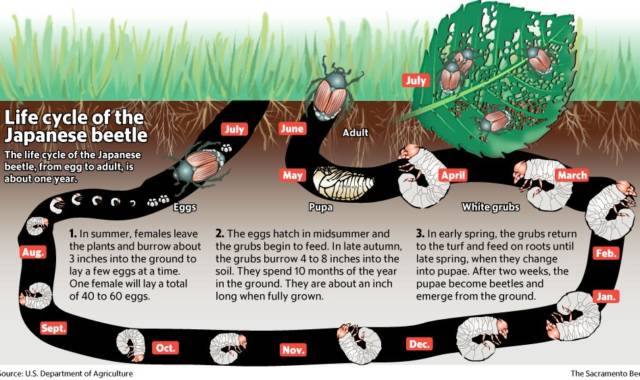 On her blog, Garden Punchlist, Betty shares an insect-plus-insecticide chart from Dr. Whitney Cranshaw, Emeritus Entomologist at Colorado State University. The chart correlates the pest with the insecticide or biological control options and especially for Japanese beetles – includes lawn treatments to take care of the grubs. These should be applied NOW, by the way, and Betty cautions that whatever product you choose, it’s important to read all the package instructions.
On her blog, Garden Punchlist, Betty shares an insect-plus-insecticide chart from Dr. Whitney Cranshaw, Emeritus Entomologist at Colorado State University. The chart correlates the pest with the insecticide or biological control options and especially for Japanese beetles – includes lawn treatments to take care of the grubs. These should be applied NOW, by the way, and Betty cautions that whatever product you choose, it’s important to read all the package instructions.
Two products contain very low-to-no impact on beneficial insects (like pollinators), and also people and pets. Beneficial nematodes (mix and spray) and grubGONE! (granular application with spreader) should both be available locally at independent garden centers or online.
What Works; What Doesn’t
 Here are a few of the tips presented by the Denver Post, under the guidance of Betty Cahill, for what works and what doesn’t when it comes to battling the Japanese beetle.
Here are a few of the tips presented by the Denver Post, under the guidance of Betty Cahill, for what works and what doesn’t when it comes to battling the Japanese beetle.
- Low mowed grass is easy for females to lay eggs in, so keep the grass at least three inches tall.
- Aficionados of natural remedies favor the plant-based insecticides like neem oil, but for Japanese beetle adults – it must contain the active ingredient azadiractin to work. The neem oil disrupts the beetles’ hormonal balance and since beneficial insects like pollinators do not eat plants, they are not harmed by the oil.
- When adding new plantings, consider ones that Japanese beetles don’t eat. A few include redbud trees, lilac, mockorange, juniper, boxwood, yews, coreopsis, columbine, coral bells, hosta, pansy and most herbs (but they do like basil!).
- Japanese beetle traps, commercial or homemade, are not recommended. They attract more beetles not only to the trap but to surrounding plants and yards.
- Organic and synthetic controls may repel or kill adults and larvae, but carefully read and study all container labels and apply when recommended — usually early morning or late evening. Read about safe pesticide application tips to insure you’re taking important precautions.
Wide Open Spaces of Crystal Valley
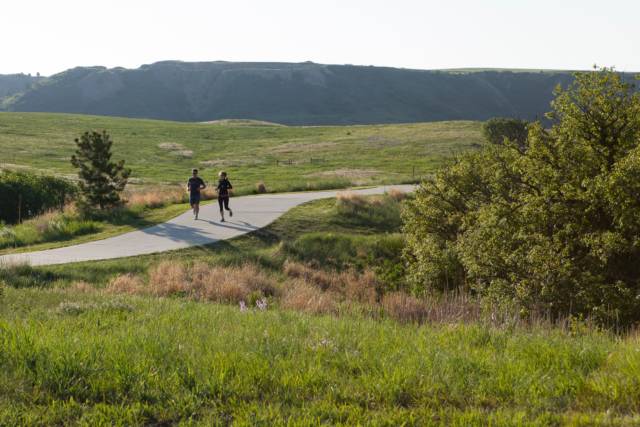 We haven’t had any reported attacks of the dreaded Japanese beetle in the master-planned community of Crystal Valley, and we’re thankful for that! No wonder buyers are flocking to the natural surroundings of this fast-growing Castle Rock community. if you’re looking for new digs, there’s never been a better time to buy a new home. Check out all 16 models from Richmond American Homes, Kauffman Homes, Century Communities and D.R. Horton to find the right fit. Our new homes offer a variety of elevations and floor plans, in ranch or two-story models — priced from the $300s.
We haven’t had any reported attacks of the dreaded Japanese beetle in the master-planned community of Crystal Valley, and we’re thankful for that! No wonder buyers are flocking to the natural surroundings of this fast-growing Castle Rock community. if you’re looking for new digs, there’s never been a better time to buy a new home. Check out all 16 models from Richmond American Homes, Kauffman Homes, Century Communities and D.R. Horton to find the right fit. Our new homes offer a variety of elevations and floor plans, in ranch or two-story models — priced from the $300s.


